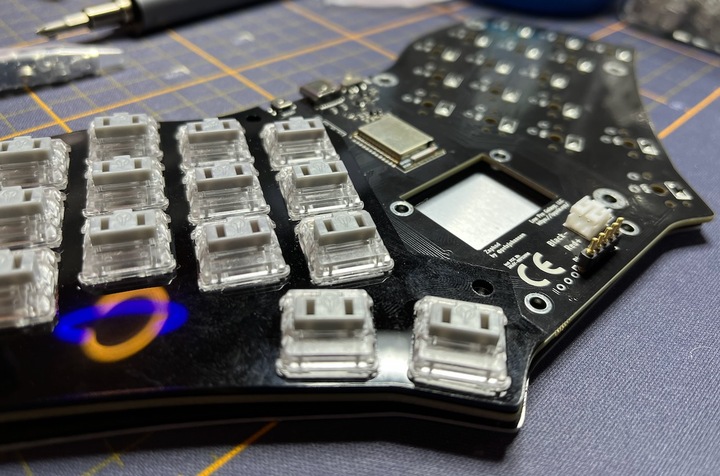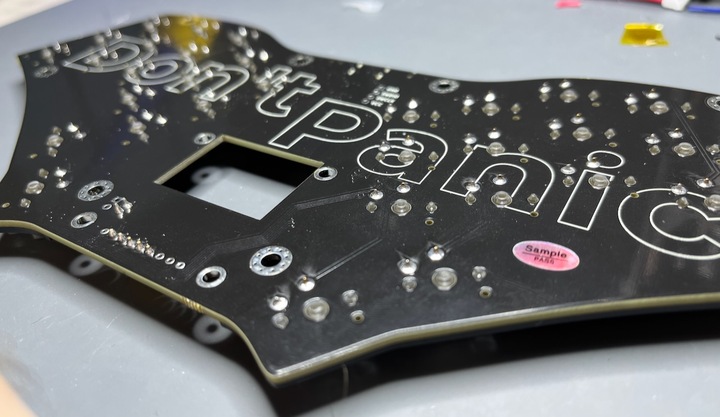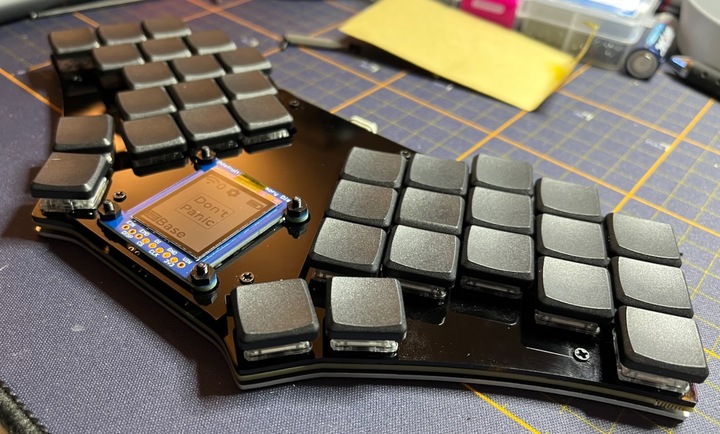sungo.io
About - RSS - CodeZaphod
Summary
- Vendor: petejohanson
- Site: https://lpgala.xyz/gb/zaphod-r1
- Purchase At: https://mkultra.click/zaphod-wireless-ble-34-key-lopro-kit/
- Style: 3x5 unibody split with column stagger,two thumb keys per side, bluetooth, display
- Key Switches: Choc Silver
- Keycaps: Black MBK
My Thoughts
The Zaphod is a BLE / USB unibody split keyboard with three rows, five columns per half, and two thumb keys per side. It has aggressive stagger, inspired by the Ferris split keyboard, and you really should download the layout tester to make sure you like it.
The PCB comes mostly assembled, either from the GB or a vendor like mkultra. You have to deal with the display and the switches. All in all, it’s an easy build. Follow the build guide particularly as it concerns the display and the spring headers.
The keyboard itself is extremely well thought out. The punchout for the larger battery, nestled under the display, is an excellent touch and that battery should last so long you forget it’s there. The display is a transreflective Sharp display that has very low power draw. It wouldn’t help much if you like to code in the dark but it’s fine if there’s a light source around.
You can’t really tell from my photos but there’s an interesting flourish in that the diodes are, when completed, housed inside the LED opening in the Choc key switch. They are completely protected. Pete tells me this was also inspired by the Ferris.
Will I use it? I don’t know. It’s five columns, compared to my usual six, so it’d take some deep keymap rework. But as I’ve discussed before in builds, I think that day is coming. I think this might be an excellent board to learn five columns, particularly if I leverage the display.
I have three warnings about the Zaphod, none of them deal breakers. Just stuff to be aware of before you buy/build.
First, the keys use choc spacing. There is over 1mm less distance between keys. If you’ve only ever used Cherry spacing or have giant fingers, the board will feel cramped. Also, some keycaps, like the WRK Louder sets, will not work. MBK caps, MoErgo MCC, and Kailh caps all work fine.
Second, the Ferris-inspired stagger is not for everyone. Grab the tester, print it out, and make sure your fingers can deal before buying. Oddly, with the choc spacing, the aggressive stagger doesn’t feel as, well, aggressive to me. But it’s certainly different.
Third, the key switches are soldered. If you’ve read any of my builds before, you’ll know how much I dislike soldered key switches. But it’s a cute little board and, at the moment, I have lots of switches to spare. If you feel super strongly about soldered switches, this ain’t the board for you.
And I have one vendor warning.
The kit from mkultra is… let’s call it a variant. Rather than using the official acrylic case (or getting it cut as fr4 which I would have loved), mkultra’s build has no switch plate, no protective cover for the electronics. You can get an aluminum bottom, which to be fair is really nice, but it doesn’t come with standoffs or long enough screws to add the acrylic or 3d print case later. My build features the acrylic case because I happen to have a laser cutter. The vast majority of the time for my build was finding standoffs and screws that’d work.
Images
There are no affiliate links present on this site. I receive no compensation, monetarily or otherwise, for outbound links. Hell, if I'm linking to a vendor site and you know of an open hardware equiv, please let me know so I can link there instead.



